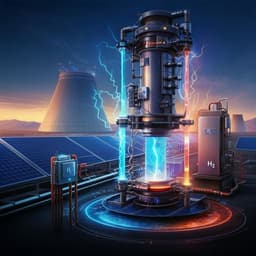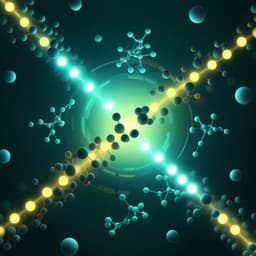
Engineering and Technology
Ultra-fast green hydrogen production from municipal wastewater by an integrated forward osmosis-alkaline water electrolysis system
G. S. Cassol, C. Shang, et al.
Explore the innovative FOWSAWE system, a groundbreaking modular approach to producing high-purity hydrogen directly from wastewater, developed by Gabriela Scheibel Cassol and her team. With a hydrogen production rate surpassing traditional methods by over 14 times, this technology promises efficient and sustainable solutions for environmental challenges.
~3 min • Beginner • English
Introduction
The study addresses the challenge of slow power-to-hydrogen conversion in membrane-assisted electrolysis systems, which limits large-scale deployment for decarbonisation despite growing renewable energy capacity and significant curtailment. Emerging P2H projects will require large volumes of water, often in regions under water stress. Prior strategies using seawater—either direct electrolysis or desalination (RO or FO-RO)—face issues including electrode degradation, parasitic chlorine evolution, membrane fouling, and added regeneration costs. The authors hypothesise that using potassium hydroxide (KOH) as both the forward osmosis (FO) draw solution and the alkaline water electrolysis (AWE) electrolyte can overcome rate and stability limitations by combining high osmotic driving force with high ionic conductivity. They further hypothesise that municipal wastewater effluent is a superior source water compared to seawater due to lower osmolarity, lower chloride (mitigating chlorine evolution), and practicality for inland sites. The research goal is to design, model, and demonstrate a modular FO–AWE system (FOWSAWE) that achieves high-rate, energy-efficient, and stable hydrogen production directly from wastewater.
Literature Review
Existing membrane-based P2H approaches include: (i) direct seawater electrolysis, which suffers from cathodic scaling, electrode corrosion, and chlorine by-products; (ii) RO desalination prior to electrolysis, limited by fouling and energy/cost; and (iii) FO-RO hybrids that mitigate fouling but incur draw-solution regeneration penalties. Recent membrane-assisted seawater electrolysis with hydrophobic PTFE membranes and FOWS using CTA membranes provided proof-of-concept but achieved <30 Nm3 day−1 m−2 H2 rates due to low vapour pressure gradients, low-conductivity neutral electrolytes, and high seawater osmolarity. Literature indicates KOH has superior ionic conductivity for AWE and can reduce chlorine evolution risks versus acidic or chloride-rich media. Wastewater effluent has been explored for FO concentration and resource recovery, offering lower salinity and chloride than seawater, and potentially reducing brine disposal concerns. These insights motivate integrating a KOH-tolerant hydrophilic FO membrane with AWE, leveraging wastewater effluent to enhance water flux and overall H2 production.
Methodology
System concept and modelling: The FOWSAWE system integrates a forward osmosis module using 1 M KOH as the draw solution to extract water from municipal wastewater effluent, with an alkaline water electrolyser (AWE) that uses the same KOH solution as electrolyte. A water–hydrogen balance model equates FO water production (QFO) to AWE water consumption (QAWE): QFO = S·A·ΔC·KW·(R·T/d) and QAWE = icell·(FE·Ncell·Vm)/(2F). This yields a linear relation for specific normalised current J = icell/S = φ·ΔC, where φ is the H2 production potential determined experimentally from FO permeability and AWE Faradaic efficiency.
FO testing: An independent FO module (two 12 cm2 chambers, 0.3 cm depth) with a commercial thin-film composite FO membrane (Porifera 051303) recirculated feed and draw at 70 mL min−1. Draw: 1 M KOH. Feed: deionised water or simulated/real wastewater effluent. Simulated effluent contained sodium acetate (≈7.5 mM), NH3/NH4+ (≈2.2–2.7 mM as N), and chloride (≈4.2 mM). Water flux (Jw, LHM) was gravimetrically measured; reverse salt flux (RSF, GHM) was determined by ICP-OES (K+). Impurity rejection was quantified for sodium acetate, NH3/NH4+, chloride (and others), with concentrations measured by TOC/TN, spectrophotometry (ammonia), and ion chromatography (chloride). Membrane integrity was assessed via SEM and FTIR before and after exposure to 1 M KOH.
AWE testing: A commercial 5-cell alkaline stack (bipolar electrodes; nickel alloy powder on nickel foam; area 15.2 cm2; diaphragm 100–130 µm) was supplied with electrolytes (1 M KOH alone or spiked with impurities). J–V curves were collected under controlled temperatures. H2 and O2 were separated via a gas–liquid separator; H2 purity was analysed by GC; Faradaic efficiency (FE) was computed from measured H2 rates versus theoretical.
Integrated FOWSAWE operation: A 1 cm2 FO membrane was coupled to the AWE loop. The extracted water diluted the KOH draw, which was reconcentrated by AWE water splitting. KOH concentration was monitored by conductivity; ΔC was computed as [KOH]recovered − 2[impurities]feed − [KOH]feed (from RSF). The specific current icell was set from the model to match QFO and QAWE for deionised water and for Hong Kong wastewater effluent (HK-WWE1). Two 5 h cycles were run for each feed. Long-term stability was evaluated over 168 h with a second Hong Kong effluent (HK-WWE2). Additional tests used wastewater from Guangdong and Northeast China to assess robustness across water qualities. Energy analysis compared specific energy consumption (SEC) with other membrane-based P2H systems and evaluated the effect of elevating KOH temperature to 40 °C via simulated waste-heat recovery.
Key Findings
• Using 1 M KOH as FO draw and AWE electrolyte enabled high water flux and stable operation. FO Jw decreased from 17.2 ± 0.3 to 14.9 ± 0.1 L h−1 m−2 over 5 h cycles; RSF was −121 ± 3 g h−1 m−2, corresponding to <1.5% loss of initial KOH per cycle.
• Membrane integrity after exposure to 1 M KOH was maintained: water flux reduction <5% versus pristine (tested with 1 M NaCl draw), comparable RSF, unchanged SEM surface morphology and FTIR spectra.
• FO rejection of key impurities remained stable over five cycles: sodium acetate ≈85%, NH3/NH4+ ≈63%, chloride ≈98%; additional impurities showed >90% rejection across varied pH in supplementary tests.
• AWE performance (J–V) with 1 M KOH was minimally affected by impurities at concentrations reflecting FO permeate (NaAc ~1.1 mM, NH3/NH4+ ~0.7 mM as N, Cl− ~0.08 mM) or even at 10 mM spikes, with FE ~99% and no evidence of side reactions.
• The water–hydrogen balance model yielded specific current requirements J = φ·ΔC; φ values derived for deionised water and HK-WWE1 corresponded to specific set currents of 1.55 and 0.95 A cm−2 at ΔC = 1 M for a 1 cm2 FO membrane, respectively.
• Integrated operation achieved dynamic equilibrium (QFO ≈ QAWE) over two 5 h cycles with stable ΔC ≈ 1 M, constant H2 production rate, and H2 purity >99% for both DI water and wastewater feeds. Wastewater feed reduced QFO and H2 rate by ~38% relative to DI water, consistent with reduced effective permeability (KWx/KW).
• Long-term 168 h test (HK-WWE2) maintained ΔC ≈ 1 M and H2 purity >99%; Jw decreased by ~12% (15.6 → 13.7 LHM) attributed to largely reversible organic fouling; cell voltage rose ~4% (1.75 → 1.82 V) and then stabilised.
• Performance versus other membrane-based P2H systems: H2 flux reached 448 Nm3 day−1 m−2 (TFC-FO area basis), 102× higher than hydrophobic PTFE-based seawater electrolysis and 14× higher than prior FOWS with CTA membranes. The improvement stems from hydrophilic TFC-FO higher permeability and larger ΔC (wastewater vs seawater), enabling much higher water production.
• Energy efficiency: SEC was 4.43 kWh Nm−3 at icell = 0.95 A (wastewater feed), which is 10%, 34%, and 84% lower than PTFE-SES, CTA-FOWS, and direct wastewater electrolysis, respectively, and comparable to industrial alkaline electrolysis.
• Thermal management: Simulated waste-heat use to raise KOH to 40 °C increased H2 flux by ~11% and reduced SEC to 3.96 kWh Nm−3, approaching IRENA’s 3.75 kWh Nm−3 target.
• Robustness: Consistent H2 production rates (within ±5%) and stable voltage/ΔC across wastewater samples from multiple regions despite varying impurity profiles and pH.
Discussion
The results validate the hypothesis that KOH can simultaneously serve as an effective FO draw solution and a high-conductivity AWE electrolyte when paired with a KOH-tolerant, hydrophilic TFC-FO membrane. The large osmotic driving force (ΔC ≈ 1 M) and high membrane water permeability enable high QFO, which directly governs the H2 production rate in the integrated membrane–electrolysis architecture. Using wastewater effluent as feed enhances performance relative to seawater by lowering osmolarity and chloride, thus increasing water flux and suppressing chlorine evolution, while minimising brine disposal issues. The water–hydrogen balance model provides a simple, scalable design rule to match membrane area, ΔC, and applied current for continuous operation, supporting modular deployment from household to city scale. Long-term stability tests show only modest, largely reversible FO fouling without loss of H2 purity or Faradaic efficiency. Compared to prior PTFE-based and CTA-based systems, the TFC-FO/AWE integration achieves order-of-magnitude gains in H2 flux and lower SEC, highlighting that water production rate is the dominant lever for improving P2H throughput. Leveraging waste heat further improves both flux and SEC, indicating synergies with thermal management in practical installations. Collectively, these findings demonstrate a viable pathway to rapid, energy-efficient green hydrogen production from alternative water resources while alleviating water scarcity constraints.
Conclusion
This work presents a modular FOWSAWE system that integrates a hydrophilic, KOH-tolerant TFC-FO membrane with alkaline water electrolysis to produce green hydrogen directly from municipal wastewater effluent at record rates. The system achieves 448 Nm3 day−1 m−2 H2 flux, H2 purity >99%, FE ~99%, and SEC as low as 3.96–4.43 kWh Nm−3, with stable operation demonstrated over 168 h and robustness across diverse wastewater qualities. A water–hydrogen balance model offers a practical framework to co-design FO and AWE modules for continuous operation across scales and sources. The approach can reduce capital and operating costs versus RO/FO-RO routes, mitigate chloride-related risks, and enable on-site resource recovery (H2 and O2) at wastewater treatment plants and industrial facilities. Future work should address scale-up of membrane area and electrolyser capacity, long-term (>months) membrane durability under high-pH and fouling conditions, optimisation of membrane materials to reduce RSF and enhance rejection of weakly rejected species (e.g., ammonia), integration of waste-heat and solar thermal management, and techno-economic and life-cycle assessments for deployment in water-stressed regions.
Limitations
• Demonstrations used small FO membrane areas (1–12 cm2) and a 5-cell AWE stack; scale-up performance, hydraulics, and system integration require validation.
• FO water flux decreased ~12% over 168 h due to organic fouling; although largely reversible, maintaining long-term performance will require periodic cleaning and fouling control strategies.
• Reverse salt flux of KOH was relatively high (−121 ± 3 GHM), though losses were <1.5% per cycle and inexpensive to replenish; reducing RSF would benefit chemical consumption and feed-side pH control.
• Wastewater impurities permeated at low levels (e.g., partial NH3/NH4+ passage) but did not affect FE or purity; however, extended multi-month accumulation effects and broader contaminant suites warrant further study.
• KOH concentrations >1 M risk membrane damage (pH >14), constraining the upper bound of ΔC; membrane material advances could expand operating windows.
• System performance relies on maintaining ΔC and matching icell via the balance model; disturbances in feed composition or temperature require control strategies.
• Energy metrics (SEC) were measured at laboratory scale and specific conditions (23–40 °C); full-system BOS losses, compression/storage, and auxiliary loads were not included.
Related Publications
Explore these studies to deepen your understanding of the subject.







